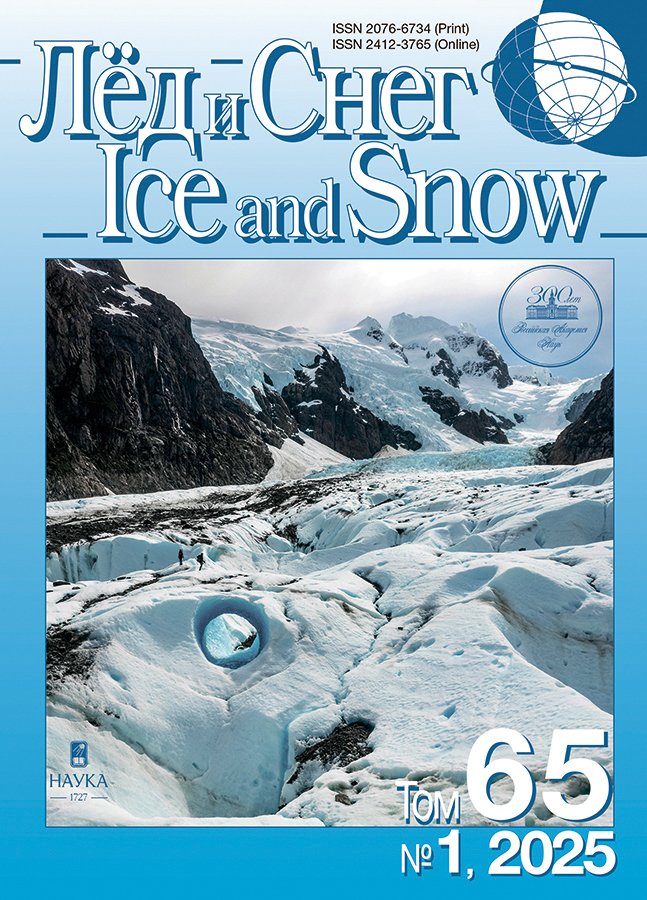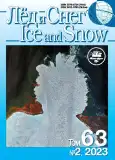Using ERA5–Land Reanalysis and Data from Weather Stations in the Mountainous Regions of Russia to Assess Changes in the Glacial Systems of Eastern Siberia and the Far East
- Authors: Titkova T.B.1, Ananicheva M.D.1
-
Affiliations:
- Institute of Geography, Russian Academy of Sciences
- Issue: Vol 63, No 2 (2023)
- Pages: 199-213
- Section: Glaciers and ice sheets
- URL: https://journals.rcsi.science/2076-6734/article/view/137468
- DOI: https://doi.org/10.31857/S2076673423020163
- EDN: https://elibrary.ru/RVIYPH
- ID: 137468
Cite item
Full Text
Abstract
This work involving the study of changes in the glacier equilibrium line altitude (ELA) is a continuance of the glaciological parameters of mountain systems investigation. The article explores the possibility of using new generation climate archives (in this case, ERA5–Land) together with weather station data on temperature and precipitation, in order to assess the climate dependence of the glacial system ELA in hard-to-reach and insufficiently studied mountain regions of the Russia Asian part. The ERA5–Land reanalysis reproduces temperature (values, dynamics, and trends) quite well in mountain systems. The use of total precipitation is possible only for assessing their dynamics and trends. The relative error for temperature trend is below 20% in both positive and negative sides, and precipitation is less than 30% in the negative one. Positive temperature trends of different intensity are observed in all mountains of the Russia Asian part with a maximum in the mountain systems of the Arctic zone. Minimal temperature trends are distinctive for coastal mountain regions of temperate latitudes. Summer temperature trends are maximum in inland areas and minimum in coastal mountain areas. The increase in precipitation in such areas occurs mainly at the expense of the cold period. It was revealed there was an increase of the glacial systems ELA from 50 to 800 m in the mountain regions of the Asian North Russia within 1966–2021. The value of the ELA rise coincides with areas of high temperature trends and may not correspond to precipitation negative trends.
About the authors
T. B. Titkova
Institute of Geography, Russian Academy of Sciences
Author for correspondence.
Email: titkova@igras.ru
Russia, Moscow
M. D. Ananicheva
Institute of Geography, Russian Academy of Sciences
Email: titkova@igras.ru
Russia, Moscow
References
- Ananicheva M.D., Krenke A.N. Evolution of the heights of the climatic snow line and the boundary of glacier feeding in the north-east of Siberia in the XX century. Materialy Glyatsiologicheskikh Issledovaniy. Data of Glaciological Studies. 2005, 98: 225–232 [In Russian].
- Ananicheva M.D., Krenke A.N. Evolution of the fields of glaciological characteristics of glacial systems in the northeast of Siberia. V sb. Izmenenie okruzhayushchej sredy i klimata: prirodnye i svyazannye s nimi tekhnogennye katastrofy. T. 3. Ch. 2. Prirodnye processy v polyarnyh oblastyah Zemli. Environmental and climate change: natural and related man-made disasters, T. 3. P. 2. Natural processes in the polar regions of the Earth. Moscow: Institute of Geography, Russian Academy of Sciences, 2008: 125–133 [In Russian].
- Ananicheva M.D. Changes in the height of the feeding boundary of glacial systems in the northeast of Siberia in the 20th and early 21st centuries. Kriosfera Zemli. Cryosphere of the Earth. 2018, 22 (6): 55–63. https://doi.org/10.21782/KZ1560-7496-2018-6(55-63) [In Russian].
- Ananicheva M.D., Pakin G.Yu., Entin A.L. Research of the Upper Angara group of glaciers. Led i Sneg. Ice and Snow. 2019, 59 (3): 423–432 [In Russian]. https://doi.org/10.15356/2076-6734-2019-3-415
- Ananicheva M.D., Krenke A.N., Barry R.G. The Northeast Asia mountain glaciers in the near future by AOGCM scenarios. The Cryosphere. 2010, 4: 435–445.
- Ananicheva M., Kononov Y., Belozerov E. Contemporary state of glaciers in Chukotka and Kolyma highlands. Bulletin of geography (Physical Geography Series). Nicolaus Copernicus University (NCU), Toruń, Poland. 2020, 19: 5–18.
- Bardin M.Yu., Rankova E.Ya., Platova T.V., Samokhina O.F., Korneva I.A. Modern changes in the surface climate based on the results of regular monitoring. Meteorologiya i gidrologiya. Meteorology and Hydrology. 2020, 5: 29–46 [In Russian].
- Bulygina O.N., Razuvaev V.N., Korshunova N.N., Shvets N.V. (a) Description of the dataset of monthly precipitation totals at stations in Russia. Certificate of state registration of the database No. 2015620394. Retrieved from: http://meteo.ru/data/158-total-precipitation#описание-массива-данных (Last access: 25 November 2022) [In Russian].
- Bulygina O.N., Razuvaev V.N., Trofimenko L.T., Shvets N.V. (b) Description of the data array of mean monthly air temperature at stations in Russia. Certificate of state registration of the database No. 201462. Retrieved from: http://meteo.ru/data/156-temperature#описание-массива-данных (Last access: 25 November 2022) [In Russian].
- Galanin A.A., Lytkin V.M., Fedorov A.N., Kadota T. Reduction of glaciers in the Suntar-Khayat Mountains and methodological aspects of its assessment. Led i Sneg. Ice and Snow. 2013, 53 (4): 30–42 [In Russian].
- Grigoriev V.Yu., Frolova N.L., Kireeva M.B., Stepanenko V.M. Spatio-temporal variability of precipitation reproduction error by ERA5 reanalysis on the territory of Russia. Izvestiya Ros. Akad. Nauk. Seriya geografi-cheskaya. Proc. of RAS. Geographical series. 2022, 86 (3): 435–446 [In Russian]. https://doi.org/10.31857/S2587556622030062
- Demchenko P.F., Semenov V.A. Estimation of the Uncertainty of Climatic Trends in Surface Temperature Associated with Internal Atmospheric. Doklady Rossiiskoy Akademii Nauk. Reports of the Academy of Sciences. 2017, 476 (3): 339–342 [In Russian]. https://doi.org/10.7868/S0869565217270202
- Krenke A.N. Mass transfer in glacial systems on the territory of the USSR. Leningrad: Hydrometeoizdat. 1982: 488 [In Russian].
- Latonin M.M., Bashmachnikov I.L., Bobylev L.P. Arctic amplification phenomenon and its driving mechanisms. Fundamental’naya i prikladnaya geofizika. Fundamental and applied geophysics. 2020, 13 (3): 3–24 [In Russian]. https://doi.org/10.7868/S2073667320030016
- Muravyov A.Ya. Glaciation change in the northern part of the middle range on the Kamchatka peninsula in the second half of the XX century. Led i Sneg. Ice and Snow. 2014, 54 (2): 22–28 [In Russian].
- Muravyov A.Ya., Nosenko G.A. Glaciation change in the northern part of the middle range on the Kamchatka peninsula in the second half of the XX century. Led i Sneg. Ice and Snow. 2013, 53 (2): 5–11 [In Russian].
- Perevedentsev Yu.P., Sherstyukov B.G., Shantalinsky K.M., Mirsaeva N.A., Aukhadeev T.R., Myagkov M.A., Parubova E.M. Changes in air temperature and atmospheric precipitation on territory of Russia in the XX‒XXI centuries. Materials of the International conference dedicated to the memory of Nina Konstantinovna Kononova. Irkutsk, 2021: 292–298 [In Russian]. https://doi.org/10.26516/978-5-9624-1956-5.2021.1-381
- Stochkute Yu.V., Vasilevskaya L.N. Dependence of the temperature and humidity regime on regional atmospheric processes. Sputnik. Estestvennye i tekhnicheskie nauki. Satellite. Natural and technical sciences. 2018, 1: 98–101 [In Russian].
- Titkova T.B., Vinogradova V.V. The timing of the occurrence of snow cover on the territory of Russia at the beginning of the 21st century according to satellite data. Led i Sneg. Ice and Snow. 2017, 1: 25–33 [In Russian]. https://doi.org/10.15356/2076-6734-2017-1-25-3
- Titkova T.B., Cherenkova E.A., Semenov V.A. Regional features of changes in winter extreme temperatures and precipitation in Russia in 1970-2015. Led i Sneg. Ice and Snow. 2018, 4: 486–497 [In Russian]. https://doi.org/10.15356/2076-6734-2018-4-486-497
- The third assessment report on climate change and their consequences on the territory of the Russian Federation. Saint Petersburg: Science-intensive technologies. 2022: 676 p. [In Russian].
- Copernicus Publications. Retrieved from: https://publications.copernicus.org (Last access: 11 August 2022).
- Gurney S.D., Popovnin V.V., Shahgedanova M., Stokes C.R. A Glacier Inventory for the Buordakh Massif, Cherskiy Range, Northeast Siberia, and Evidence for Recent Glacier Recession // Arctic, Antarctic, and Alpine Research. 2008, 1: 81–88.
- Haeberli W., Zemp M. Mountain glaciers: on thin ice. Mountains and climate change: from understanding to action. Bern. 2009: 22–29.
- Khromova T., Nosenko G., Nikitin S., Muraviev A., Po-pova V., Chernova L., Kidyaeva V. Changes in the mountain glaciers of continental Russia during the twentieth to twenty-first centuries // Regional Environmental Change. 2019, 19: 1229–1247.
- Kim M., Lee E. Validation and Comparison of Climate Reanalysis Data in the East Asian Monsoon Region // Atmosphere. 2022, 13: 1589. https://doi.org/10.3390/atmos13101589
- Muñoz-Sabater J., Dutra E., Agustí-Panareda A., Albergel C., Arduini G., Balsamo G., Boussetta S., Choulga M., Harrigan S., Hersbach H., Martens B., Miralles D., Piles M., Rodríguez-Fernández J., Zsoter E., Buontempo C., Thépaut J. ERA5-Land: a state-of-the-art global reanalysis dataset for land applications. Earth Syst. Sci. Data. 2021, 13: 4349–4383. https://doi.org/10.5194/essd-13-4349-2021
- Special Report IPCC on the Ocean and Cryosphere in a Changing Climate “High Mountain Areas”. The Intergovernmental Panel on Climate Change (IPCC). 2019.
- Yamada T., Takahashi Sh., Shiraiwa T., Fudjii Y., Kononov Yu.M., Ananicheva M.D., Koreisha M.M., Muraviev Ya.D., Samborsky T.V., Reconnaissance of the 31 Glacier in the Suntar-Khayata Range, Sakha Republic, Russian Federation. Japanese Society of Snow and Ice. Bulletin of Glaciologic research. 2002, 19: 101–106.
- Kononov Y.M., Ananicheva M.D., Willis I.C. The millennium dynamics of Polar Ural glaciers by high resolution reconstruction of glacier mass balance // Annals of Glaciology. 2005, 42: 163–171.
Supplementary files

















